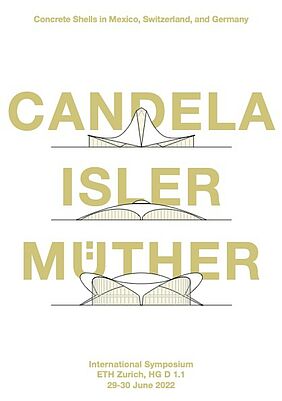Organizer: Chair for the Theory of Architecture, Prof. Dr. L. Stalder and Chair of Structural Design, Prof. Dr. J. Schwartz
Date: Wednesday, 29 June 2022 to Thursday, 30 June 2022
Time: 13.30 to 18.00
Location: ETH Main Building, Rämistrasse 101, Zurich, HG D 1.1
An international symposium on the work and influence of Félix Candela, Heinz Isler and Ulrich Müther will take place in Zurich on June 29th and 30th, 2022. It concludes a three-part series of events that began in 2018 and is being organised at the Institute for the History and Theory of Architecture (gta) in cooperation with the Chair of Structural Design at ETH Zurich, the Universidad Nacional Autónoma de México (UNAM), and the Müther-Archive at the University of Applied Sciences in Wismar.
Programm
The work of Félix Candela (1910–1997), Heinz Isler (1926–2009) and Ulrich Müther (1934–2007) coincides with the heyday of concrete shell construction in the second half of the 20th century, which the architect Candela in Mexico and the USA shaped just as decisively as the engineers Isler and Müther in Switzerland and the GDR respectively. Across the boundaries of political systems, they engaged in a lively professional exchange that took place via personal networks and organizations such as the International Association for Shell Structures (IASS), founded in 1959. Notwithstanding their mutual influences and their common field of activity in general, their professional work in particular is characterised by remarkable differences that need to be highlighted. While Candela became the undisputed master of elegant shells in Mexico, which were mostly used in public buildings, Isler positioned himself successfully as an entrepreneurial engineer in the Swiss Mittelland, particularly with his system of industrial shells that was optimized in terms of planning and construction processes. Müther, for his part, was able to achieve a monopoly position under the conditions of the socialist planned economy, both in the design and execution of such buildings by his own construction company.
Besides early projects and milestones in the work of the three protagonists, the two-day symposium at ETH Zurich will embed their work in the contemporary historical context. Their experimental form-finding methods will be subject of the lectures, as will their work with new building materials such as plastic or aluminium. In addition, the question will be investigated to what extent thin-walled concrete shells can be made fruitful for today’s construction practice. In the meantime, the historical shell structures of the 20th century are being worn down by the ravages of time, which is why the symposium will also look at exemplary works from the perspective of monument preservation in order to discuss problems and potential of their conservation.
Participation in the symposium is free of charge, no registration is required.
Partners
Universidad Nacional Autónoma de México (UNAM), Facultad Arquitectura
University of Applied Sciences, Technology, Business and Design Wismar, Müther-Archive
Funding
Swiss National Science Foundation (SNSF) as part of the research project “Experimental Design in the Post-War Period – Heinz Isler's (1926–2009) Contribution in the Perspective of the History of Engineering and Culture”
Dr. Rainer Schützeichel
